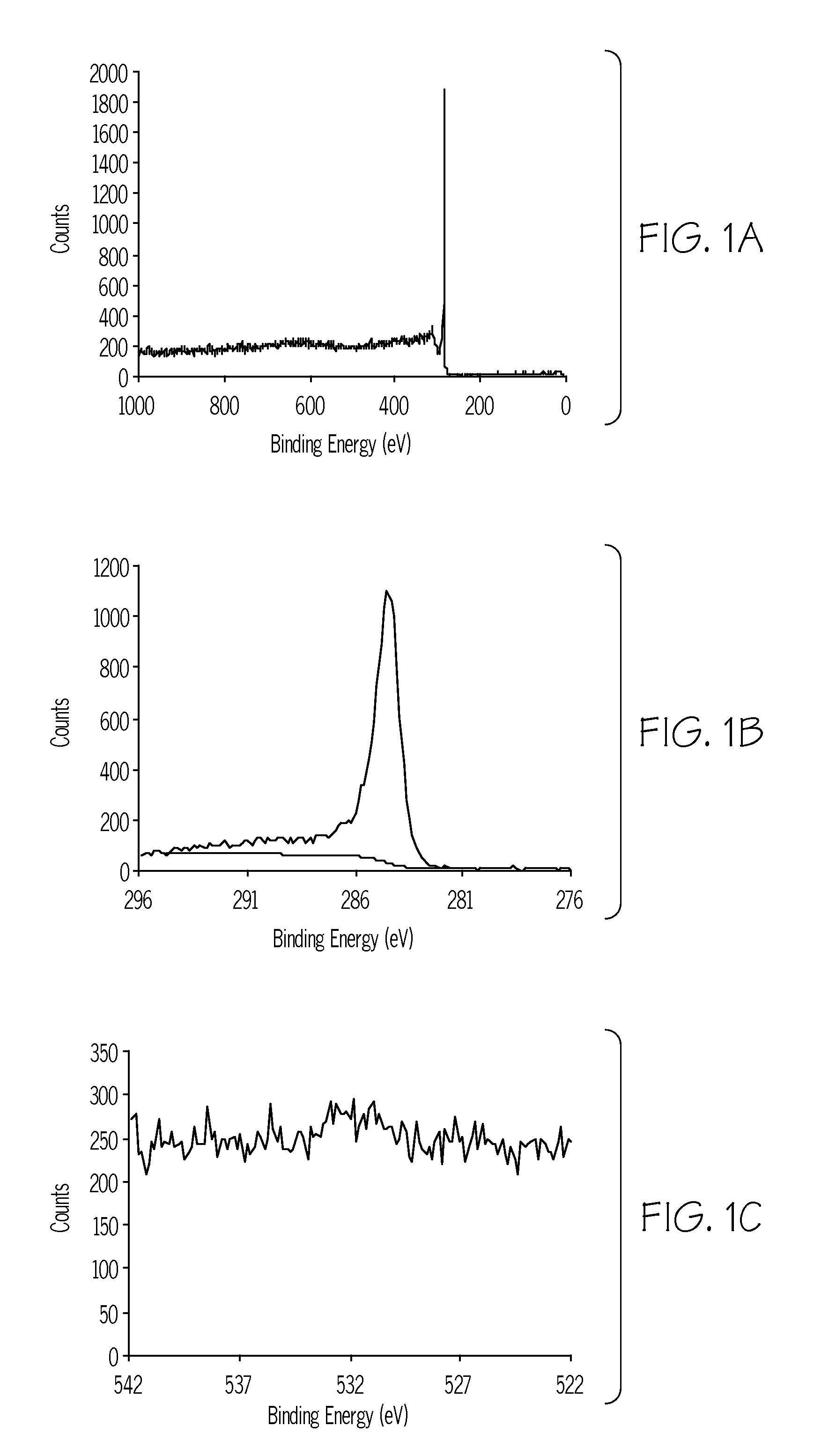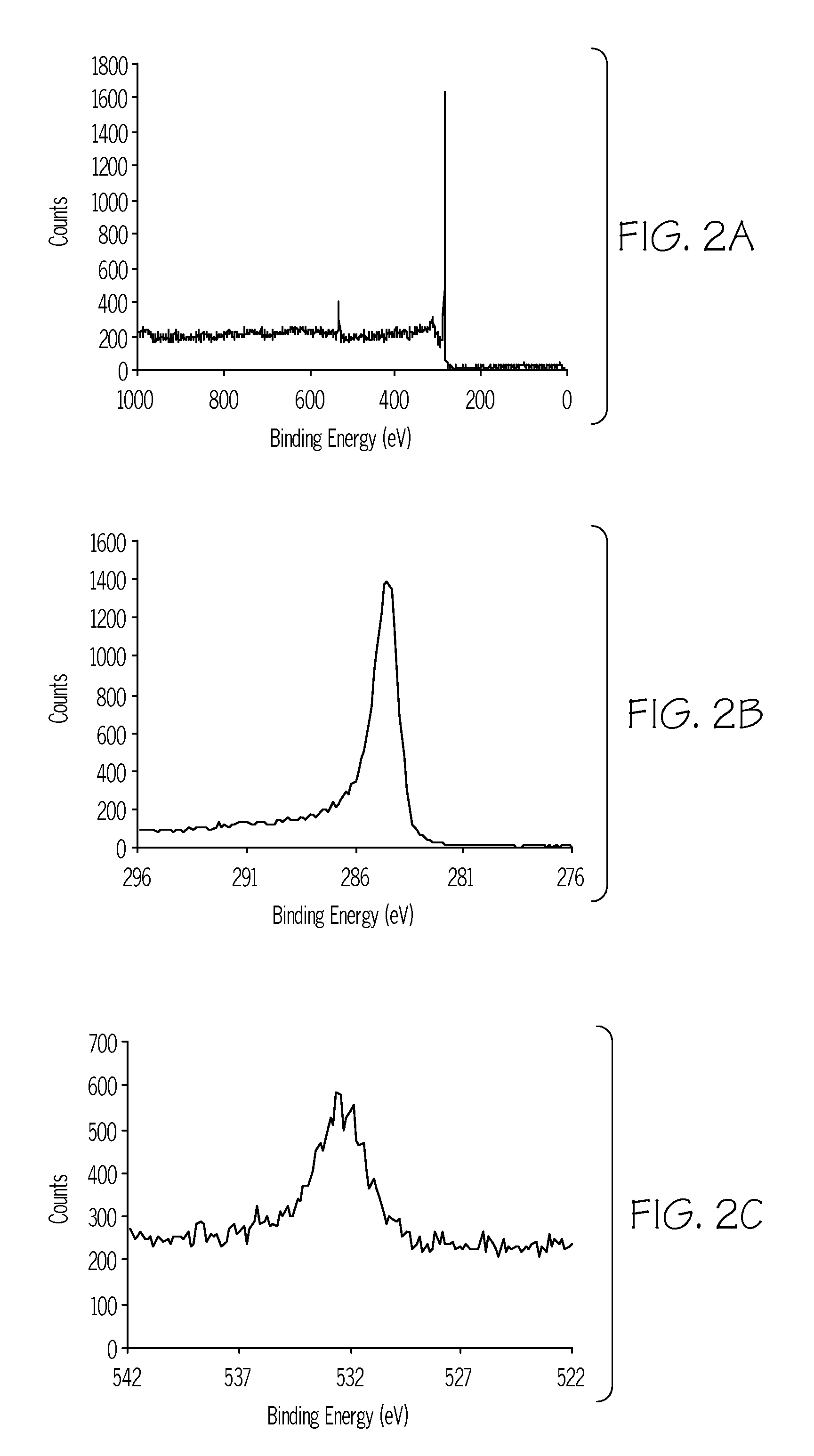Method of modifying carbon nanomaterials, composites incorporating modified carbon nanomaterials and method of producing the composites
a carbon nanomaterial and composite material technology, applied in the field of carbon nanomaterial modifying, composites incorporating modified carbon nanomaterials and the method of producing composites, can solve the problems of cnts being cut into shorter fragments, cnts being damaged, and adding more defects on the surface of cnts
- Summary
- Abstract
- Description
- Claims
- Application Information
AI Technical Summary
Problems solved by technology
Method used
Image
Examples
example 1
Plasma Treatment
[0034]The plasma treatment of carbon nanotubes was carried out under different chemical vapors (alkyl amines, alcohols, aldehyde, acetonitrile, acetic acid, and hexane) with a base pressure of 20 mTorr and monomer vapor pressure ranging from 50 to 1000 mTorr for 10 sec to 2 h.
A) CNTs Before Plasma Treatment
[0035]The XPS (X-ray photoelectron spectroscopy) survey spectrum of the raw CNTs (FIG. 1A) shows a carbon peak only. The high resolution C 1s spectrum (FIG. 1B) gives a graphite-like carbon peak while the corresponding high resolution O 1s spectrum (FIG. 1C) shows almost no detectable oxygen signal within the experimental error.
B) CNTs After Acetic Acid Plasma Treatment
[0036]After the plasma treatment with acetic acid vapor at 100 mTorr for 10 s, the XPS survey spectrum of the plasma-modified CNTs (FIG. 2A) shows both oxygen and carbon peaks. The percentage content of C and O atoms in the acetic acid plasma treated CNTs were calculated from the high resolution C 1s...
example 2
Hydrogenated Nitrile Butadiene Rubber and Multi-Wall Carbon Nanotube (HNBR / MWNT) Composites
[0037]A desired amount of the acetic acid or hexane plasma-treated CNTs was mixed with a predetermined amount of raw HNBR sample in an extruder at 160° C. for 10 min before being extruded out. The crosslinking initiator was added to the HNBR / carbon nanotube mixture and blended at 100° C. for another 10 min. The mixture sample was pressed at 176° C. (350° F.) for 20 min to crosslink in a sheet form.
[0038]As shown in FIG. 3, the composite with 4 wt % acetic acid plasma-treated carbon nanotubes had a stress of 365 psi at 300% strain, which is 53% higher than the control sample (i.e., 0% CNTs). With 1 wt % acetic acid plasma-treated carbon nanotubes, the stress of the composite increased to 334 psi. Overall, the samples with acetic acid plasma-treated carbon nanotubes had better mechanical properties than those of the hexane plasma-treated carbon nanotubes. This is presumably because the plasma-in...
example 3
HNBR / Poly(vinyl acetate) (PVAc) / MWNTs
[0041]A desired amount of the acetic acid plasma-treated carbon nanotubes was mixed with 10 wt % PVAc in N,N-dimethyl formamide with a ratio of 1:1 by weight, followed by sonication at room temperature for 1 h. The solvent was evaporated under vacuum at 80° C., and the solid residue was further dried in oven at 80° C. for 48 h to produce the PVAC / MWNT mixture. A desired amount of the PVAc / MWNT mixture was added into a HNBR sample in an extruder at 160° C. for 10 min and extruded out. Weight ratios of the MWNT / HNBR in the resulting samples are 1 / 100, 2 / 100 and 4 / 100 (designated as: HNBR / PVAc / CNT-x, where x is the weight ratio of MWNT to HNBR). The crosslinking initiator was added to the MWNT / HNBR mixture at 100° C. for 10 min. The samples were pressed at 176° C. (350° F.) for 20 min to crosslink in a sheet form. The control sample was the raw HNBR crosslinked using the above procedure with the crosslinking initiator, but without CNTs.
[0042]As seen...
PUM
| Property | Measurement | Unit |
|---|---|---|
| time | aaaaa | aaaaa |
| pressure | aaaaa | aaaaa |
| vapor pressure | aaaaa | aaaaa |
Abstract
Description
Claims
Application Information
 Login to View More
Login to View More - R&D
- Intellectual Property
- Life Sciences
- Materials
- Tech Scout
- Unparalleled Data Quality
- Higher Quality Content
- 60% Fewer Hallucinations
Browse by: Latest US Patents, China's latest patents, Technical Efficacy Thesaurus, Application Domain, Technology Topic, Popular Technical Reports.
© 2025 PatSnap. All rights reserved.Legal|Privacy policy|Modern Slavery Act Transparency Statement|Sitemap|About US| Contact US: help@patsnap.com



